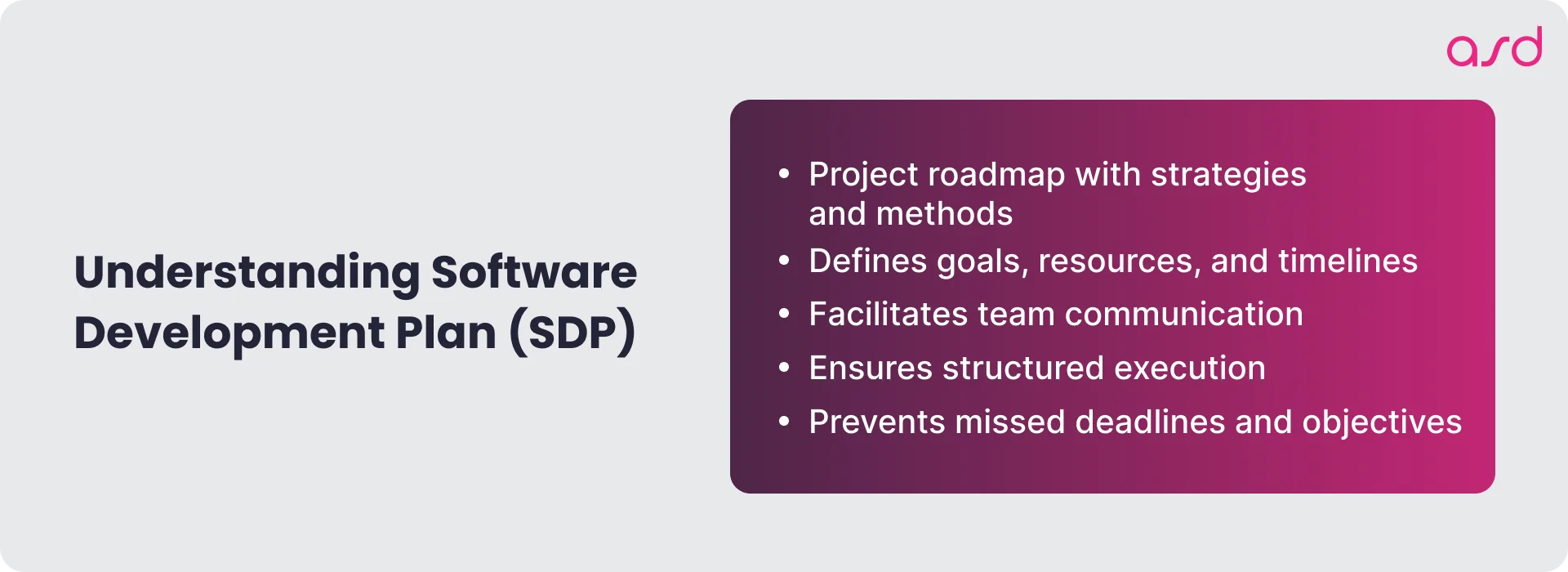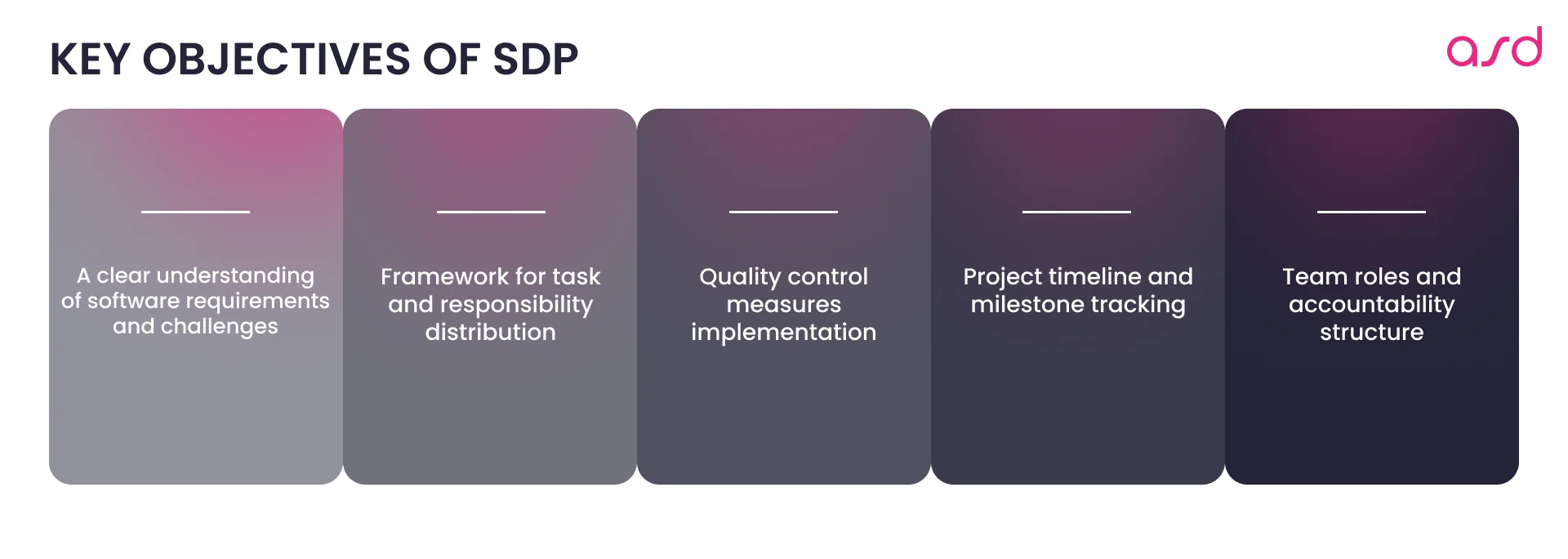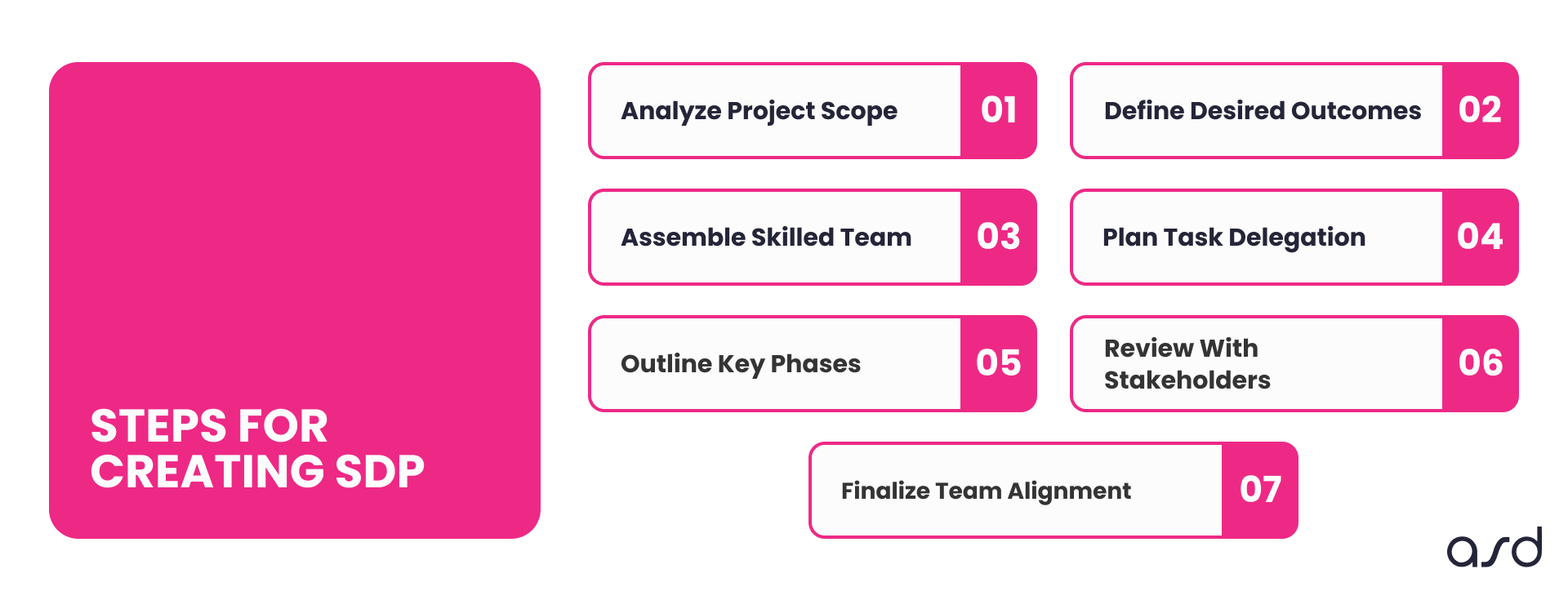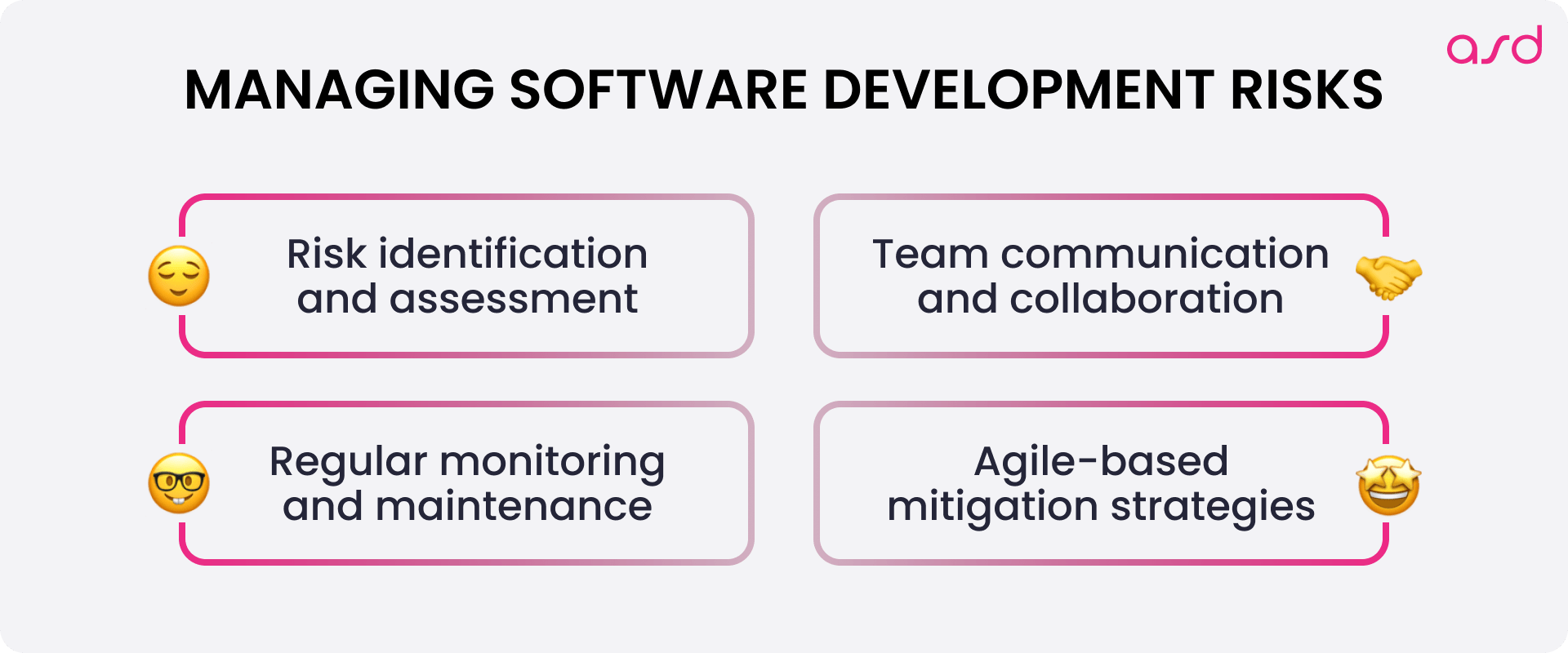Table of Content
- Understanding a SDP
- Key Objectives of a SDP
- Benefits of SDP
- Essential Elements of a SDP
- Steps to Create a SDP
- Testing and Quality Assurance
- Tracking Progress with Milestones and KPIs
- Software Project Structure and Organization
- Post-Project Review and Continuous Improvement
- Common Mistakes to Avoid in Software Development Planning
- Utilizing Software Development Plan Templates
Book a free software planning consultation
Book a callA successful software development plan is your project’s roadmap. This guide shows how to create one, ensuring you stay on track and meet your goals.
Key Takeaways
- A comprehensive Software Development Plan (SDP) is crucial for defining project goals, resources, timelines, and challenges to ensure successful software development. A well-structured software project plan serves as a straightforward, task-based guideline essential for achieving these objectives.
- Key components of an effective SDP include clear project objectives, detailed timelines, task assignments, and integrated risk management strategies.
- Post-project reviews and continuous improvement practices are vital for learning from past projects to enhance future software development planning.
Understanding a Software Development Plan
A Software Development Plan (SDP) is the backbone of any software project. It details the strategy and methods for executing the project, offering a thorough roadmap that covers the processes, timelines, resources, and tasks involved. This plan acts as a guiding star, helping the development team navigate the project’s lifecycle, and aligning everyone towards common goals.
The SDP serves multiple purposes. It helps in defining the project’s goals, resources, timelines, tasks, and potential challenges. It also facilitates effective communication among team members and stakeholders, crucial for project success. Effective software project planning within the SDP ensures that development execution is structured and monitored, making it easier for teams to organize tasks, set deadlines, and evaluate software performance post-deployment. Without a clear and detailed plan, software development projects can easily become aimless, leading to missed deadlines and unmet objectives.
Thus, a well-crafted SDP is essential for any project aiming for success.

Key Objectives of a Software Development Plan
The primary aim of a software development project plan is to provide the development team with a clear understanding of the software being developed and the challenges associated with it. This clarity helps ensure a systematic and structured development process, which significantly enhances the likelihood of the project’s success. For example, what is the main goal in projects direct bookings vs. ota? Clearly defining the issues the project aims to address sets the stage for effective problem-solving and innovation.
Another critical objective of an effective software development plan is to outline a framework for task assignments, team responsibilities, and quality control measures. Clarifying roles and responsibilities within the development team is crucial for the efficient execution of the plan. Additionally, the SDP should detail project timelines, major tasks, and critical milestones, ensuring that everyone involved is aware of the project’s progress and any adjustments needed along the way.

Benefits of Software Development Planning
Software development planning offers numerous benefits to development teams, project managers, and stakeholders. Some of the key advantages of software development planning include:
-
Improved Project Outcomes
A well-planned software development project is more likely to meet its objectives, deliver high-quality software, and satisfy stakeholders. By setting clear goals and expectations, the development team can focus on delivering a product that meets user needs and business requirements.
-
Increased Efficiency
Software development planning helps teams to prioritize tasks, allocate resources effectively, and manage their time more efficiently. With a detailed project plan, development teams can streamline their workflows, reduce bottlenecks, and ensure that tasks are completed on schedule.
-
Better Risk Management
By identifying potential risks and developing mitigation strategies, software development planning enables teams to minimize the impact of unexpected issues and ensure project continuity. Proactive risk management helps in addressing technical, operational, and business risks before they escalate.
-
Enhanced Collaboration
Software development planning promotes collaboration among team members, stakeholders, and project managers, ensuring that everyone is aligned and working towards common goals. Clear communication and defined roles foster a collaborative environment, reducing misunderstandings and enhancing teamwork.
-
Reduced Costs
Effective software development planning can help teams avoid costly rework, reduce waste, and optimize resource utilization, leading to cost savings and improved budget management. By planning ahead, project managers can allocate resources more efficiently and avoid unnecessary expenses.
-
Improved Communication
Software development planning facilitates clear and transparent communication among stakeholders, ensuring that everyone is informed and up-to-date on project progress and changes. Regular updates and status reports keep all parties aligned, reducing the risk of miscommunication and ensuring that the project stays on track.
Essential Elements of a Software Development Plan
An effective software development plan relies on multiple essential components. These key elements contribute to its success. Firstly, it must outline the project’s scope, project goals, and requirements clearly. Defining the project’s scope helps ensure alignment among team members and stakeholders, facilitating a shared vision and effective project execution. These goals should focus on the business problem at hand and include specific, measurable objectives that can be used to track the software project plan’s success. Without clear requirements, there’s a risk of developing a product that doesn’t meet user needs.
The plan should also include a detailed timeline with specific milestones and deadlines to keep the project on track. Additionally, it’s essential to allocate resources, including personnel, tools, and technologies, to support the development process effectively.
Lastly, risk management strategies should be integrated into the plan to anticipate and mitigate potential challenges during the project’s lifecycle.
Discover about the role of the requirements in software development
Steps to Create a Comprehensive Software Development Plan
Creating a comprehensive software project plan involves several crucial steps. The process begins with analyzing the project scope to ensure that everyone understands the project’s boundaries and desired outcomes. Next, a skilled development team must be assembled to ensure effective collaboration and task delegation.
Drafting the initial plan involves outlining key phases and objectives. This draft should then be reviewed and refined based on feedback from team members and stakeholders to address any potential issues beforehand. Finally, the plan is finalized, ensuring alignment and agreement among all team members before moving forward.

Let’s delve deeper into each of these steps.
-
Analyzing Project Scope
Defining the project’s scope is the first step in creating a software development plan. This involves delineating what the project should and should not cover. By clearly outlining the project’s scope, you ensure that all team members, project managers, stakeholders, and key decision-makers share a common vision and understanding of the project’s objectives.
Gathering detailed requirements through methods such as interviews, workshops, and discussions helps document the project’s scope accurately. It’s also essential to consider factors like timeline, budget, and task dependencies to avoid scope creep and ensure controlled adjustments throughout the development process. Documenting this information is crucial for setting the right direction for the project.
-
Assembling Your Development Team
Assembling a skilled software development partner (team) is crucial for the project’s success. The plan should detail the project organization, including the roles and responsibilities of each team member. Clear roles and responsibilities foster accountability and enhance collaboration within the project team and the development team.
It’s important to match roles and capabilities with the project’s scope to ensure that each team member is well-suited for their tasks. In agile projects, dividing the team into smaller independent units focused on distinct phases can enhance efficiency and reduce potential bottlenecks. Ensuring effective team collaboration can prevent misunderstandings and errors that could delay the project timeline.
-
Drafting the Initial Plan
The initial draft should outline a comprehensive software project plan, including clear objectives, project scope, and deliverables. This plan helps in specifying the project’s intentions and preferred endpoints. Detailing the methodologies and tools to be used ensures a consistent approach across the team.
A clear project schedule highlighting major milestones and deadlines is essential for keeping the team on track. Listing the tools and technologies to be used ensures a consistent workflow and supports resource allocation. It’s also important to specify timelines for meetings, progress reviews, and celebration of milestones to maintain team motivation and alignment.
-
Reviewing and Refining the Plan
Gathering feedback from team members and stakeholders is crucial for refining the software development project plan. After creating the first draft, share it with project stakeholders and team members for their input. This collaborative approach helps identify any potential issues early on and allows for adjustments to be made before finalizing the plan.
Incorporating feedback effectively ensures that the plan is robust and addresses all critical aspects of the project. This iterative process of reviewing and refining helps in creating a solid software development plan that is well-aligned with the project’s goals and requirements.
-
Finalizing the Software Development Plan
The final stage of creating a software development plan involves ensuring agreement from all team members and stakeholders. Discussing suggestions for extending deadlines and tools is essential before finalizing the timeline. Including a communication plan ensures that all team members are aligned and have access to the completed plan.
The plan should also cover non-functional requirements and a checklist for the transition to service. Allocating sufficient time and resources for the maintenance handover of the completed system or product is crucial for post-go-live support.
Rushing the deployment phase can lead to significant flaws, so it’s important to ensure thorough testing and quality assurance before finalizing the plan.
Risk management is a critical component of a successful software development project plan. It involves identifying, assessing, and mitigating potential risks that could impact the project’s success. Implementing risk management strategies helps in addressing technical, operational, and business risks systematically.
Regular communication among team members helps proactively address risks and foster collaboration. Developing a risk management plan provides a reference for the team on how to handle identified risks effectively. Regular monitoring and maintenance checks are also vital for ongoing risk mitigation in software projects.
Adopting an Agile approach allows teams to identify and address risks at each sprint, rather than only at the project’s end.

Testing and Quality Assurance
Testing and quality assurance are critical components of the software development process. They ensure that the software meets the required standards, is reliable, and functions as expected. Some key aspects of testing and quality assurance include:
-
Test Planning
Developing a comprehensive test plan that outlines the testing approach, scope, and schedule. A well-defined test plan ensures that all aspects of the software are tested thoroughly and systematically.
-
Test Execution
Executing the test plan, identifying defects, and reporting test results. This phase involves running various tests to validate the software’s functionality, performance, and security, ensuring that it meets the specified requirements.
-
Defect Management
Managing defects, tracking their status, and ensuring that they are resolved promptly. Effective defect management involves logging defects, prioritizing them based on severity, and coordinating with the development team to fix them.
-
Quality Assurance
Ensuring that the software meets the required quality standards, is reliable, and functions as expected. Quality assurance activities include code reviews, static analysis, and adherence to coding standards and best practices.
-
Continuous Testing
Integrating testing into the development process, ensuring that the software is tested continuously throughout its development lifecycle. Continuous testing helps in identifying and addressing issues early, reducing the risk of defects in the final product.
Looking for a bulletproof team?
Tracking Progress with Milestones and KPIs
Tracking progress with milestones and key performance indicators (KPIs) is essential for ensuring that a software project stays on track and meets its objectives. Milestones act as critical checkpoints, enabling teams to evaluate progress and adjust strategies accordingly. They motivate teams by providing tangible goals to strive for throughout the project’s lifecycle.
KPIs provide quantifiable metrics to determine if a project is on track to meet its objectives. Using SMART criteria to define KPIs ensures that they are aligned with overall project goals and can be measured effectively. Tracking KPIs ensures focus on important aspects of the project, avoiding inconsequential details and enabling proactive identification of risks and areas needing attention.
![]()
Failing to monitor project progress can lead to budget overruns and failure to meet project goals as a project manager.
Software Project Structure and Organization
A well-structured and organized software project is essential for its success. Some key aspects of software project structure and organization include:
-
Project Governance
Establishing a clear project governance structure, defining roles and responsibilities, and ensuring that decision-making processes are in place. Effective governance ensures that the project is managed efficiently and that all stakeholders are aligned with the project’s objectives.
-
Project Organization
Organizing the project team, defining roles and responsibilities, and ensuring that communication channels are established. A well-organized project team enhances collaboration and ensures that tasks are assigned to the right individuals based on their skills and expertise.
-
Project Artifacts
Creating and maintaining project artifacts, such as project plans, status reports, and meeting minutes. These artifacts provide a record of the project’s progress and decisions, ensuring transparency and accountability.
-
Configuration Management
Managing changes to the software, ensuring that changes are tracked and that the software is properly configured. Configuration management helps maintain the integrity of the software and ensures that all changes are documented and approved.
-
Release Management
Planning and managing the release of the software, ensuring that it is properly tested and that stakeholders are informed. Release management involves coordinating with various teams to ensure a smooth deployment and transition to production.
By focusing on these key aspects, you can ensure that your software project is well-structured, organized, and set up for success.
Post-Project Review and Continuous Improvement
Post-project reviews are crucial for understanding what worked well and identifying areas for improvement in future initiatives. These reviews promote accountability among team members regarding their contributions and help in maintaining positive relationships with stakeholders.
Documenting key findings from post-project reviews fosters a culture of continuous improvement within organizations. A structured post-project review includes assessing performance against initial goals and documenting lessons learned. This process typically involves planning, data collection, analysis, and formulation of actionable recommendations.
Common Mistakes to Avoid in Software Development Planning
Common mistakes in software development planning can lead to significant issues and project failures. Here are some common pitfalls to avoid:
- Unclear goals
- Rough estimates
- Lack of documentation
- Disconnected teams
- Undefined project scope
- Insufficient stakeholder involvement
- Lack of clear objectives
- Poor timeline estimation
By being aware of these mistakes, you can improve your planning process and increase the chances of project success.
Lack of attention to risks and inadequate planning often lead to failures in a software development plan. The change management process is essential to manage and approve changes to project scope, objectives, or timelines.
Thorough documentation is crucial to prevent miscommunication and minimize downtime during the project.
Utilizing Software Development Plan Templates
Utilizing a structured software development plan template can simplify the planning process by ensuring that all key aspects are addressed systematically. Templates provide a pre-structured framework that promotes effective communication among team members and stakeholders, aligning their expectations.
Templates offer a standardized format that can be reused, saving time for teams working on similar projects. Using templates can lead to a more organized, efficient, and cohesive project planning process. This approach helps in creating a solid software development plan that ensures project success and alignment with overall goals.
Level up your dev planning Schedule a no-cost consultation and let our specialists guide you through your development planning

Summary
Crafting an effective software development plan is crucial for the success of any software project. By understanding the key objectives, essential elements, and step-by-step process of creating an SDP, you can ensure that your project stays on track, meets its goals, and satisfies all stakeholders.
Remember, a well-crafted software development plan is the foundation of a successful project. It provides clarity, direction, and a roadmap for the development team, ensuring that everyone is aligned and working towards the same objectives. As you embark on your next software development project, take the time to create a comprehensive and detailed plan that sets you up for success.
Questions? Answers!
What are the essential elements of a software development plan?
A comprehensive software development plan must include clear project goals and requirements, defined timelines and milestones, allocated roles and responsibilities, effective resource planning, and robust risk management strategies. These components ensure a structured approach toward achieving project success.
What are the common pitfalls to avoid when creating a software development plan, and how can they impact the project’s success?
Common pitfalls in creating a software development plan include unclear objectives, inadequate risk assessment, poor resource allocation, and lack of stakeholder communication. These issues can lead to missed deadlines, budget overruns, scope creep, and ultimately, project failure. Addressing these challenges early ensures smoother execution and better alignment with project goals.
How can templates help in creating a software development plan?
Templates streamline the creation of a software development plan by offering a pre-structured framework that covers all essential elements. This enhances communication among team members and stakeholders, ultimately resulting in a more organized and efficient planning process.
What are the key objectives of a software development plan?
The key objectives of a software development plan are to ensure a clear understanding of the software being developed, outline team responsibilities, and establish a structured framework for systematic development, ultimately enhancing project success.
What are the 7 steps of a software development plan?
The seven steps of software development are analysis, planning, design, development, testing, deployment, and maintenance. Following these steps ensures a systematic approach from concept to a fully functioning product.
